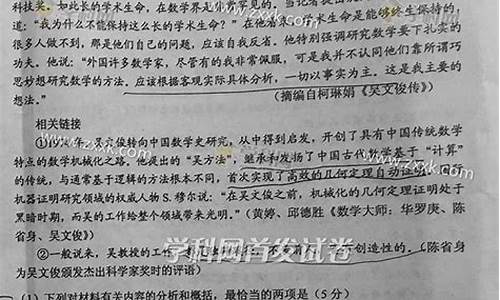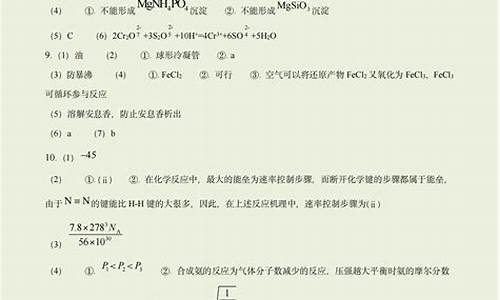您现在的位置是: 首页 > 教育政策 教育政策
2021高考非谓语动词学科网-2014高考非谓语动词
tamoadmin 2024-10-16 人已围观
简介1.高考的语法题中如何区分位于动词和非谓语动词2.非谓语动词(to do,doing)作表语和定语的区别3.非谓语动词4.高考英语非谓语动词巧记巧用5.高中英语非谓语动词讲解高考的语法题中如何区分位于动词和非谓语动词这么说吧,动词的全称就是谓语动词。你问的实际上就是谓语动词和非谓语动词的区别。一个句子里只能出现一个动词,如果有两个,咱们就把其中一个变成非谓语,方法是加ed 或ing.被动是ed.主
1.高考的语法题中如何区分位于动词和非谓语动词
2.非谓语动词(to do,doing)作表语和定语的区别
3.非谓语动词
4.高考英语非谓语动词巧记巧用
5.高中英语非谓语动词讲解
高考的语法题中如何区分位于动词和非谓语动词

这么说吧,动词的全称就是谓语动词。你问的实际上就是谓语动词和非谓语动词的区别。一个句子里只能出现一个动词,如果有两个,咱们就把其中一个变成非谓语,方法是加ed 或ing.被动是ed.主动是ing
非谓语动词(to do,doing)作表语和定语的区别
doing既可指动名词,也可指现在分词,现主要为你讲解动名词与不定式的用法区别。 动名词与不定式都是动词的一种非限定形式,是中学英语的一项重点内容,也是高考及各类考试的常考内容之一。动名词与不定式的用法及区别归纳如下: 一、作主语 1.不定式与动名词均可作主语,两者常可换用。例如: Cleaning the playground / To clean the playground is her fulltime job. 打扫操场的卫生是她的专职工作。 To watch / Watching them play football is very interesting. 看他们踢足球是很有趣的。 2. 注意前后一致的原则,如主语是不定式或动名词,表语也用不定式或动名词。例如: To see her is to love her.谁看见她都会喜欢她。 Saving is having. 节约即是收入。 3. 但如果作主语的不定式是固定的说法,或表示一种强烈的对比,或指具体的某次动作等时,通常不用动名词代替不定式。例如: To love others is to be loved. 爱人即爱己。(表示对比) To learn a language in one month is impossible. 在一个月内学会一门语言是不可能的。(表示某次具体的动作) 二、作表语 1. 不定式和动名词均可作表语,解释或说明主语的具体内容,两者常可换用,但需要注意主语与表语的一致性。例如: My work is looking after / to look after the children.我的工作是照看这些孩子。 To live is to do something worthwhile. 活着就是要做一些有价值的事情。(比较:Living is doing something worthwhile.) 2. 如果表示某种结果、不幸的命运或预言,或表示"同意;命令;决定;劝告"等意,则往往用不定式作表语。例如: The important thing is to save lives. 救人要紧。 You are to hand in the exercises tomorrow. 你们必须明天交练习。 三、作宾语 1. 有些动词后可接动名词作宾语,但不可接不定式作宾语;有些动词则反之。详细内容见本报第1期第1面"动词不定式过关指导"。 2. begin, start, hate, like, love, prefer 等动词后接不定式与接动名词区别不大,但这类动词与 should 或 would 连用时,只接不定式;begin 或 start 用于进行时态时,后面常常接不定式。例如: I don't like troubling / to trouble him. 我不想去麻烦他。 Would you like to leave a message? 你要不要留个话儿? 3. 某些动词后接动名词与接不定式意义不同。这类动词常用的有 remember, forget, regret, stop, try, mean 等。如 remember, forget 后接不定式表示未发生的动作,接动名词表示已发生的动作;regret 后接不定式表示"遗憾;抱歉",常与 to say, to tell, to inform 等连用, 后接动名词指对已发生的事表示"后悔或悔恨";stop to do sth. 表示"停下来去做某事", stop doing sth. 表示"停止做某事";try to do sth. 表示"试图做某事",try doing sth. 表示"试试做某事";mean to do sth. 表示"有意或打算做某事", mean doing sth. 表示"意味着……"。例如: I remember seeing you somewhere in Guilin.我记得在桂林的什么地方见到过你。(seeing 这个动作已经发生) Remember to mail the letter for me. 记住帮我寄这封信。(to mail 这个动作尚未发生) 4. want 及 need 表示主语"想或需要"做某事,后接不定式的主动式作宾语;want, need 及 require 表示主语"需要"被作某种处置,后接动名词的主动式或接不定式的被动式均可。例如: I want to paint the wall. 我想粉刷这堵墙。 The wall wants painting / to be painted. 这墙需要粉刷了。 四、作定语 1. 动名词作定语表示名词的属性或事物的用途。例如: No one is allowed to speak aloud in the reading room. 阅览室里不准大声说话。 There is a swimming pool in our school. 我们学校有一个游泳池。 2. 不定式作定语表示将要发生的动作。例如: That will be the only thing to do now. 那恐怕是目前唯一可行的办法。 Is that the best way to solve the problem?那是解决这个问题的最好办法吗?
非谓语动词
非谓语动词的用法
非谓语动词主要包括不定式、动名词和现在分词。为了区分这三种不同的非谓语动词的用法和含义,可以分别从三种非谓语动词在句子中做主语、宾语、宾语补足语、定语、状语、表语以及一些特殊结构句型等角度来区分其用法和细微含义。
1.不定式和动名词作主语的区别
(1)动名词作主语通常表示抽象动作;而不定式作主语表示具体动作。
Smoking is prohibited(禁止)here.这里禁止抽烟。(抽象)
It is not very good for you to smoke so much.你抽这么多烟对你身体很不好。(具体)
(2)动名词作主语时,通常用以表示一件已知的事或经验。
不定式短语通常用来表示一件未完成的事(在后面有解说)或目的。
Climbing mountains is interesting.爬山很有趣。(经验)
Driving a car during the rush hour is tiring.在高峰时刻开车令人厌烦。(经验)
(3)不定式做主语,一般用it当形式主语,把作主语的不定式短语后置。
It took me only five minutes to finish the job.
2.不定式、动名词和分词作表语的区别
(1)不定式作表语
1)不定式作表语一般表示具体动作,特别是表示将来的动作。
To do two things at a time is to do neither.--次做两件事等于未做。
What I would suggest is to start work at once.我的建议是立刻开始干。
(2)主表一致
如果主语是不定式(表示条件),表语也是不定式(表示结果)。
To see is to believe.百闻不如一见。
To work means to earn a living.工作就是为了生活。
(3)如果主语是以aim, duty, hope, idea, happiness, job, plan, problem, purpose, thing, wish等为中心的名词,或以what引导的名词性从句,不定式作表语是对主语起补充说明 作用。
His wish is to buy a luxurious car in the near future.他的希望是在不远的将来买一辆豪华轿车。
The function of Louis Sullivan's architecture was to provide large uninterrupted floor areas and to allow ample light into the interior.
The most important thing is to negotiate with them about the future of the plant.
(2)动名词作表语:动名词作表语,表示抽象的一般性的行为。
Our work is serving the people.我们的工作是为人民服务。
His hobby is collecting stamps.他的爱好是集邮。
注:动名词作表语时与进行时态中的现在分词形式相同,但其所属结构迥异,进行时态说明动作是由主语完成的。动名词做表语,说明主语的性质或情况。
People cannot but feel puzzled, for they simply cannot understand how he could have made such a stupid mistake.
His victory in the final was no more convincing than I had expected.
(3)分词作表语
分词做表语有两种情况,一种是现在分词做表语,一种是过去分词做表语,这两者区别是考试中经常考到的地方。一般来说,表示心理状态的动词如excite, interest等都是及物动词,汉语意思不是“激动”,“高兴”,而是“使激动”、“使高兴”,因而现在分词应该是“令人激动的”、“令人高兴的”,过去分词则是“感到激动的”和“感到高兴的”。所以,凡表示“令人……的”都是-ing形式,凡是表示“感到……”都用-ed形式。换句话说,若人对……感兴趣,就是somebody is interested in...,若人/物本身有兴趣时,就是说sb./sth. is interesting.
这类词常见的有:
interesting使人感到高兴--interested感到高兴的
exciting令人激动的--excited感到激动的
delighting令人高兴的--delighted感到高兴的
disappointing令人失望的--disappointed感到失望的
encouraging令人鼓舞的--encouraged感到鼓舞的
pleasing令人愉快的--pleased感到愉快的
puzzling令人费解的--puzzled感到费解的
satisfying令人满意的---satisfied感到满意的
surprising令人惊异的--surprised感到惊异的
worrying令人担心的--worried感到担心的
Travelling is interesting but tiring.旅行是有趣的,但是使人疲劳。
The pupils will get confused if they are made to learn too much.如果要学生学得太多,他们会感到糊涂的。
The argument is very convincing.他的论点很令人信服。
They were very excited at the news.听到这个消息,他们非常激动。
3.不定式和动名词作宾语的区别
英语中大多数动词既可跟不定式,也可跟动名词作直接宾语,但有些动词要求:
(1)不定式做宾语和宾语补足语
1)下面的动词要求不定式做宾语
attempt企图 enable能够 neglect忽视
afford负担得起 demand要求 long渴望
arrange安排 destine注定 mean意欲,打算
begin开始 expect期望 omit忽略,漏
appear似乎,显得 determine决定 manage设法
cease停止 hate憎恨,厌恶 pretend假装
ask问 dread害怕 need需要
agree同意 desire愿望 love爱
swear宣誓 volunteer志愿 wish希望
bear承受 endeavor努力 offer提供
beg请求 fail不能 plan计划
bother扰乱;烦恼 forget忘记 prefer喜欢,宁愿
care关心,喜欢 happen碰巧 prepare准备
decide决定 learn学习 regret抱歉,遗憾
choose选择 hesitate犹豫 profess表明
claim要求 hope希望 promise承诺,允许
start开始 undertake承接 want想要
consent同意,赞同 intend想要 refuse拒绝
decide决定 learn学习 vow起
contrive设法,图谋 incline有…倾向 propose提议
seek找,寻觅 try试图
2)下面的动词要求不定式做宾补:动词+宾语+动词不定式
ask要求,邀请 get请,得到 prompt促使
allow允许 forbid禁止 prefer喜欢,宁愿
announce宣布 force强迫 press迫使
bride 收买 inspire鼓舞 request请求
assist协助 hate憎恶 pronounce断定,表示
advise劝告 exhort告诫,勉励 pray请求
authorize授权,委托 help帮助 recommend劝告,推荐
bear容忍 implore恳求 remind提醒
beg请求 induce引诱 report报告
compel强迫 invite吸引,邀请, summon传唤
command命令 intend想要,企图 show 显示
drive驱赶 mean意欲,打算 train训练
cause引起 instruct指示 require要求
deserve应受 leave使,让 tell告诉
direct指导 like喜欢 tempt劝诱
entitle有资格 order命令 warn告诫
enable使能够 need需要 urge激励,力说
encourage鼓励 oblige不得不 want想要
condemn指责,谴责 lead引起,使得 teach教
entreat恳求 permit允许 wish希望
(2)有少数动词只能用动名词作宾语
acknowledge承认,自认 cease 停止 mention说到,讲到
admit 承认 tolerate忍受 dislike不喜欢,讨厌
advocate:提倡,主张 complete完成 dread可怕
appreciate 感激,欣赏 confess坦白 endure忍受
avoid避免 contemplate细想 enjoy享有,喜爱
bear忍受 defer拖延 envy嫉妒
can't help不禁 delay延迟 escape逃跑,逃避
can't stand受不了 deny否认 excuse借口
consider 考虑 detest嫌恶 fancy幻想,爱好
favor 造成,偏爱 mind 介意 repent悔悟
figure描绘,计算 miss错过 resent怨恨
finish完成,结束不得 pardon原谅,饶恕 resist抵抗,阻止
forgive原谅 permit 允许 resume恢复
imagine设想 postpone延迟,延期 risk冒险
involve卷入,包含 practise 实行,实践 suggest建议
hate讨厌 prevent阻止 save营救,储蓄
keep保持 quit放弃停止 stand坚持,忍受
loathe非常讨厌,厌恶 recall回想
例如:I appreciate having been given the opportunity to study abroad two years ago.我很感激两年前给我出国学习的机会。
(3)有些动词后使用动名词和动词不定式作宾语的差别
1)forget to do 忘记要去做某事(此事未做)
forget doing忘记做过某事(此事已做过或已发生)
2)stop to do 停止、中断(某件事),目的是去做另一件事
stop doing 停止正在或经常做的事
3)remember to do 记住去做某事(未做)
remember doing记得做过某事(已做)
4) regret to do对要做的事遗憾
regret doing对做过的事遗憾、后悔
5)try to do努力、企图做某事
try doing试验、试一试某种办法
6) mean to do打算,有意要…
mean doing意味着
7)go on to do 继而(去做另外一件事情)
go on doing 继续(原先没有做完的事情)
8)propose to do 打算(要做某事)
proposing doing建议(做某事)
9) like /love/hate/ prefer +to do 表示具体行为;+doing sth 表示抽象、倾向概念
(注)如果这些动词前有should一词,其后宾语只跟不定式,不能跟动名词。例如:
I should like to see him tomorrow.
10) need, want, deserve +动名词表被动意义;+不定式被动态表示“要(修、清理等)”意思。
Don't you remember seeing the man before?你不记得以前见过那个人吗?
You must remember to leave tomorrow.你可要记着是明天动身。
I don't regret telling her what I thought.我不后悔给她讲过我的想法。(已讲过)
I regret to have to do this, but I have no choice.我很遗憾必须这样去做,我实在没办法。(未做但要做)
You must try to be more careful.你可要多加小心。
Let's try doing the work some other way.让我们试一试用另外一种办法来做这工作。
I didn't mean to hurt your feeling.我没想要伤害你的感情。
This illness will mean (your) going to hospital.得了这种病(你)就要进医院。
4.不定式、现在分词和过去分词作定语的区别
(1)不定式作定语
1)不定式与其所修饰的名词可能是主谓关系
He was the last one to leave school yesterday.昨天他是最后一个离开教室的。
The train to arrive was from London.将要到站的火车是从伦敦开来的。
2)不定式与其所修饰的名词可能是动宾关系
Get him something to eat.给他拿点儿东西吃。
She has a lot of work to do in the morning.早上他有很多工作要做。
3)不及物动词构成的不定式做定语,要加上适当的介词和被修饰的名词形成逻辑上的动宾关系,这里的介词不能省去。
I need a pen to write with.我需要一支笔写字。
There is nothing to worry about.没有什么值得发愁的。
4)不定式修饰一些表示方向、原因、时间、机会、权利等抽象名词如:
ability能力,本领 drive赶,驾驶 movement运动,活动
ambition抱负,野心 effort努力,尝试 need需要,需求
campaign战役,运动 failure失败,不及格 opportunity机会
chance机会 force力,压力,要点 promise许诺,希望
courage勇气 intention意向,意图 reason理由,原因
decision决定 method方法,方式 light光,光线,亮光
determination决心,决定 motive动机,目的 struggle奋斗,努力,
tendency倾向,趋势 wish希望,愿望,祝愿
5)被修饰的名词前有序数词、形容词最高级或next, second, last, only和not a,the等限定词时候,只能用不定式。
6)不定代词something, nothing, little, much, a lot 等习惯上用不定式做定语。
John will do anything but work on a farm.除了农活,约翰什么都愿意干。
7)如果其动词要求用不定式做宾语,或者其形容词要器接不定式做补语,则相应的名词一般用不定式做定语。如: tend to do---tendency to do;decide to do = decision to do;be curious to do = curiosity to do
His wish to buy a car came true.他要买辆车的愿望实现了。
Their decision to give up the experiment surprised us.
他们放弃这个实验的决定使我们大吃一惊。
He is always the first to come and the last to leave.
他总是第一个到来,最后一个离去。
(2)分词作定语
分词作定语时有下面几个特点:
1)现在分词表示主动意义,过去分词一般表示被动含意。
2)现在分词表示正在进行,过去分词表示状态或做完(完成)的事。
He rushed into the burning house.他冲进了正在燃烧着的房子。
The child standing over there is my brother.站在那儿的男孩子是我弟弟。
The room facing south is our classroom.朝南的房间是我们的教室。
Have you got your watch repaired? 你拿到那个修好的表了吗?
He is an advanced teacher.他是个先进教师。
3)下列不及物动词也以过去分词形式做定语或表语,但不具有被动意义,这点要注意:
departed, elapsed, faded, fallen, gone, frown-up, retired, returned, risen, set, vanished.
(3)不定式和分词作定语时的时间关系
一般来说,不定式所表示的动作发生在谓语动词所表示的动作之后;现在分词所表示的动作与谓语动词所表示的动作同时发生;过去分词表示的动作发生在谓语动词所表示的动作之前。例如:
Do you want to see the doctor to be sent for from Beijing?
你要见那位将从北京请来的医生吗?
Do you want to see the doctor working on the case report in the office?
你要见那位正在办公室里写病历的医生吗?
5.不定式和分词作状语的区别
(1)现在分词与过去分词作状语的区别。
现在分词做状语与过去分词做状语的最主要区别在于两者与所修饰的主语的主动与被动关系的区别。
1)现在分词作状语时,现在分词的动作就是句子主语的动作,它们之间的关系是主动关系。
He went out shutting the door behind him.
他出去后将门随手关上。
Not knowing what to do, he went to his parents for help.
由于不知如何办是好,他去找父母帮忙。
2)过去分词作状语时,过去分词表示的动作是句子主语承受的动作,它们之间的关系是被动关系。
Given more attention, the trees could have grown better.
如果对这些树多关心一些,它们本来会长得更好。
Faced with difficulties, we must try to overcome them.
在遇到困难的时候,我们必须设法克服。
(2)动词不定式和分词作状语的区别
1)分词作状语一般表示伴随,而不定式常常表示目的。
They stood by the roadside talking about the plan.他们站在路边谈论着这个计划。(伴随)
They stood by the roadside to talk about the plan.他们站在路边为的是谈论这个计划。(目的)
2)分词作状语放在句子开头,除表示原因之外有时表示时间或条件。动词不定式作状语时,除了表示目的以外,还表示结果或原因。
Reading attentively,he forgot the time for lunch.由于在专心读书,他忘了吃午饭的时间。(原因)
Reading carefully,he found something he had not known before.他仔细读书时,发现了一些从前不知道的东西。(时间)
Reading carefully,you'll learn something new.只要你仔细阅读,你会学到一些新的东西。(条件)
His family was too poor to support him.他的家庭太穷,不能维持他的生活。(结果)
The boy is not tall enough to reach the book shelf.这男孩个子不够高,手伸不到书架。(结果)
We are glad to hear the news.我们很高兴听到这消息。(原因)
(3)下面一些句型是不定式做状语时候应该注意的:
a:not/never too…to, too…not to , but/only too… to, too ready/eager/apt/inclined to 表示肯定意义
b:做结果状语的不定式只能出现在句子的末尾,常见的不定式动词有:find, hear, see, be told, form, give, make, produce 等。
c:不定式做状语时,其逻辑主语一般为句子的主语,否则用for引导主语。
6.非谓语动词常考的其它结构
(1)疑问词+不定式结构
疑问词who,what,which,when,where和how后加不定式可构成一种特殊的不定式短语。它在句中可以用作主语、宾语、表语和双重宾语。如:
When to start has not been decided.何时动身尚未决定。(主语)
I don't know what to do.我不知道该怎么办。(宾语)
The difficulty was how to cross the river.困难在于如何过河。(表语)
I can tell you where to get this book.我可以告诉你哪里可以买到此书。(双重宾语)
注)A.有时疑问词前可用介词,如:
I have no idea of how to do it.我不知道如何做此事。
B.动词know 后面不能直接跟不定式作宾语,只能跟疑问词(如:how, what)+不定式:
While still a young boy, Tom knew to play the piano well and as he grew older, he wrote operas, the most famous of which is Carmen.
(2)介词except和but作“只有…,只能…”讲时跟不定式结构(but与不带to的不定式连用)。
When the streets are full of melting snow, you cannot help but getting your shoes wet.
(3)不带to的不定式
1)在表示生理感觉的动词后的不定式不带to。这类词有:
feel 觉得 observe 注意到,看到 overhear听到
watch注视 listen to听 perceive察觉,感知
notice注意 see看见 look at看 hear听
On seeing the young child fell into the lake,Eric sprang to his feet,and went on the rescue.
2)另一类是某些使役动词,如make, let,have等。如:
Let him do it.让他做吧。
I would have you know that I am ill.我想要你知道我病了。
(注):
①上述感觉动词与使役动词转换为被动结构时.其后的不定式一般需带to,如:
He was seen to come.
The boy was made to go to bed early.
②在动词find与help之后,不定式可带to亦可不带to,如:
He was surprised to find the sheep (to) break fence at this season.他发现羊在此季节越出栅栏,感到惊讶。
3)在do nothing/anything/everything but(except)结构中。例如:
Last night I did nothing but watch TV.昨天晚上,我除了看电视别的什么也没有干。
但是,如果谓语动词不是“do nothing,anything,everything”,那么but(except)所跟的不定式则仍须带。
The doctor told him nothing but to stop smoking.医生除了让他戒烟,其它什么都没有说。
There was nothing for them to do but to remain silent.除了保持沉默以外,他们没有别有别的办法。
(4)不定式与动名词的逻辑主语和分词独立结构
1)不定式的逻辑主语为:for +名词(或代词宾格)+ 不定式。例如:
I found it impossible for him to do the job alone.我发现他—个人干这活是不可能的。
(注)在表示人物性格、特性等的形容词后面,常用of引出不定式的逻辑主语。例如:
It was wise of him to do that.他那样做是明智的。
2)动名词的逻辑主语为;①人称代词的所有格+动名词;②名词's+动名词。例如:
Tom insisted on my going with them.他坚持要我和他们一起去。
He dislikes his wife's working late.他不喜欢他妻子工作得很晚。
3)某些形容词,如:careless等不定式后可以加of来引导出其逻辑主语。这类词主要有:absurd, bold, brave, courageous, careful, careless, clever, wise, foolish, silly, stupid, good, nice, kind thoughtful, considerate, greedy, generous, honest, modest, polite, rude, cruel ,selfish, wicked, wrong等
It is very kind of you to help me.你帮助我太好了。
间或也可用for + there to be表示(而且there后面的不定式只能是to be)。
It's a great pity for there to be much trouble in the company.太遗憾了公司里有这么多的麻烦。
7.非谓语动词中的有关句型
(1)动名词作主语的句型
1)Doing...+ v. Reading is an art.阅读是门艺术。Seeing is believing.眼见为实。
2) It is + no use, no good (fun, a great pleasure, a waste of time, a bore...)等名词+doing sth.
It is no use crying.哭没有用。It is no good objecting.反对也没有用。
It is a great fun playing football.打篮球很有趣。
It is a waste of time trying to explain.设法解释是浪费时间。
3)It is + useless (nice, good,interesting, expensive等形容词)+ doing sth.
It is useless speaking.光说没用。
It is nice seeing you again.真高兴又遇到了你。
It is good Playing chess after supper.晚饭后弈棋挺好。
It is expensive running this car.开这种小车是浪费。
much-traveled, newly-arrived, recently-come
高考英语非谓语动词巧记巧用
高考英语非谓语动词巧记巧用
一、接不定式和接动名词意义不同的动词和短语
在下列8个动词和短语动词后接不定式和接动名词意义不同:
remember to do(记住去做) remember doing(记得做过)
forget to do(忘记去做) forget doing(忘记做过)
regret to do (遗憾地做) regret doing(后悔做了)
try to do(设法做) try doing(试做)
go on to do(接着做另一事) go on doing(继续做同一事)
mean to do(打算做) mean doing(意味着)
stop to do(停下来去做) stop doing(停止做)
can’t help to do(不能帮助做) can’t help doing(情不自禁做)
1. —You were brave enough to raise objection at the meeting.
—Well, now I regret ________ that. (全国卷)
A. to do B. to be doing
C. to have done D. having done
分析答案选D。由语境可知“我”“后悔”在会上提出异议,应接动名词。
2. —The light in the office is still on.
—Oh,I forgot ________. (全国卷)
A. turning it off B. turn it off
C. to turn it off D. having turned it off
分析答案选C。表示忘记做某事,事情还没做,forget后接不定式。
3. In some parts of London, missing a bus means ________ for another hour. (上海卷)
A. waiting B. to wait
C. wait D. to be waiting
分析答案选A。由语境可知句中的mean表示“意味着”,后接不定式。
4. She reached the top of the hill and stopped ________ on a big rock by the side of the path. (全国卷)
A. to have rested B. resting
C. to rest D. rest
分析答案选C。休息是停下来的目的,且发生在stop之后,用接不定式的一般式。
5. Go on ________ the other exercise after you have finished this one. (全国卷)
A. to do B. doing
C. with D. to be doing
分析答案选A。表示做完一事后“接着做”另一事,go on后接不定式。
二、表示未成实现的愿望或打算的动词和短语
表示未曾实现的愿望或打算,即表示“本打算 / 想 / 希望做某事”但事实上却没做的事情,用plan, intend, mean; want, hope, wish, expect等动词的过去完成时,加不定式的一般式,或者这类动词的一般过去时,加不定式的完成式;was / were, would / should like加不定式的完成式;was / were going加不定式的一般式。如:
I would love ________ to the party last night but I had to work extra hours to finish a report. (全国卷)
A. to go B. to have gone
C. going D. having gone
分析答案选B。由句意可知,是表示过去未曾实现的期望,用“would love+不定式完成式”。句意是:昨晚我本想去参加聚会的,但是…(from www.nmet168.com)
三、要接动名词的含有介词的常用句型
在介词后一般用动名词,下面是一些含介词的固定句式(其中有的介词有时会被省略):prevent / stop / keep sb. / sth. from doing (阻止…做…);spend / waste time or money in doing (在做…方面花费 / 浪费时间或金钱);How / What about doing sth. (做…怎么样?);have some difficulty / trouble in doing (在做…方面有些困难);have a hard time in doing sth. (做某事很艰难); there is no sense in doing(做…是没有理由 / 道理的);thank (excuse / admire / praise / blame / scold / punish) sb. for doing sth. (因做某事而感谢 / 羡慕 / 表扬 / 责备某人)等。如:
1. Having been ill in bed for nearly a month, he had a hard time ________ the exam. (福建卷)
A. pass B. to pass
C. passed D. passing
分析答案选D。因为have a hard time (in) doing sth. 在做某事方面有困难。
2. According to a recent U. S. survey, children spend up to 25 hours a week ________ TV. (上海卷)
A. to watch B. to watching
C. watching D. watch
分析答案选C。spend some time (in) doing sth. 做某事花了多长时间。
3. I believe that’s the best way to prevent such a thing ________ again. (全国卷)
A. to happen B. from happening
C. happened D. happen
分析答案选B。prevent sb. / sth. from doing 阻止…做…。
4. Did you have trouble ________ the post office? (全国卷)
A. to have found B. with finding
C. to find D. in finding
分析答案选D。have difficulty / trouble (in) doing sth. 在做方面有困难。
四、to是介词的常用固定结构
to是介词和固定词组很多,常见的有:look forward to(盼望), devote…to / be devoted to(致力于), be / get used to(习惯), lead to(导致), get down to(开始认真), pay attention to(注意), refer to(谈到), point to(指向), turn to(转向), object to(反对), equal to(等于、能胜任), belong to(属于)等。如:
1. Mr. Reed made up his mind to devote all he had to ________ some schools for poor children. (上海卷)
A. set up B. setting up
C. have set up D. having set up
分析答案选B。devote…to…中to是介词,接动名词;all是devote的宾语,he had是省略了关系代词that的定语从句。
2. The discovery of new evidence led to ________. (上海卷)
A. the thief having caught B. catch the thief
C. the thief being caught D. the thief to be caught
分析答案选C。lead to中的to是介词,后接动名词;逻辑主语the thief与catch是被动关系,所以用动名词的被动式(from www.nmet168.com)。
3. She looks forward every spring to ________ the flower-lined garden. (上海卷)
A. visit B. paying a visit
C. walk in D. walking in
分析答案选D。look forward to中to是介词,后接动名词。再说,若visit用作名词,后面要加介词to,才可接宾语,排除A和B;walk作名词,表示散步,仅用于go for / take / have a walk等结构,排除C。
高中英语非谓语动词讲解
一、非谓语动词种类及句法功能
(一)概述:
在英语中,不作句子谓语,而具有除谓语外其他语法功能的动词,叫做非谓语动词。非谓语动词有动词不定式(the Infinitive);动名词(the Gerund);现在分词(the Present Participle);过去分词(the Past Participle)。
1.非谓语动词与谓语动词的相同点有:
(1)如果是及物动词都可与宾语连用,例如:
They built a garden.
They suggested building a garden.
(2)都可以被状语修饰:
The suit fits him very well.
The suit used to fit him very well.
(3)都有主动与被动, “体”式(一般式;进行式;完成式)的变化。例如:
He was punished by his parents.(谓语动词被动语态)
He avoided being punished by his parents.(动名词的被动式)
We have written the composition.(谓语动词的完成时)
Having written the composition, we handed it in.(现在分词的完成式)
(4)都可以有逻辑主语
They started the work at once.(谓语动词的逻辑主语)
The boss ordered them to start the work.(动词不定式的逻辑主语)
We are League members.(谓语动词的主语)
We being League member, the work was well done.
(现在分词的逻辑主语)
2、非谓语动词与谓语动词的不同点有:
(1)非谓语动词可以有名词作用(如动词不定式和动名词),在句中做主语、宾语、表语。
(2)非谓语动词可以有形容词作用(如动词不定式和分词),在句中做定语、表语或宾语补足语。
(3)非谓语动词可以有副词作用(如动词不定式和分词),在句中作状语。
(二)非谓语动词的句法功能:
二、非谓语动词用法:
(一)动词不定式:(to)+do,具有名词、形容词、副词的特征。
1.不定式的形式:(以动词write为例)
否定式:not + (to) do
(1)一般式:不定式的一般式所表示的动作与谓语动词动作同时发生或发生在谓语动词动作之后,
例如:
I'm glad to meet you.
He seems to know a lot.
We plan to pay a visit.
He wants to be an artist.
The patient asked to be operated on at once.
The teacher ordered the work to be done.
(2)进行式:不定式的进行式所表示的动作与谓语动词动作同时发生,例如:
The boy pretended to be working hard.
He seems to be reading in his room.
(3)完成式:不定式的完成式表示的动作发生在谓语动词动作之前,例如:
I regretted to have told a lie.
I happened to have seen the film.
He is pleased to have met his friend.
2.不定式的句法功能:
(1)作主语:
To finish the work in ten minutes is very hard.
To lose your heart means failure.
动词不定式短语作主语时,常用it作形式主语,例如上面两句可用如下形式:
It is very hard to finish the work in ten minutes.
It means failure to lose your heart.
(2)作表语:
Her job is to clean the hall.
He appears to have caught a cold.
(3)作宾语:
常与不定式做宾语连用的动词有:want, hope, wish, offer, fail, plan, learn, pretend, refuse, manage, help, agree, promise, prefer, 如果不定式(宾语)后面有宾语补足语,则用it作形式宾语,真正的宾语(不
定式)后置,放在宾语补足语后面,例如:
Marx found it important to study the situation in Russia.
动词不定式也可充当介词宾语,如:
I have no choice but to stay here.
He did nothing last Sunday but repair his bike.
动词不定式前有时可与疑问词连用,如:
He gave us some advice on how to learn English.
(4)作宾语补足语:
在复合宾语中,动词不定式可充当宾语补足语,如下动词常跟这种复合宾语:want, wish, ask, tell, order, beg, permit, help, advise, persuade, allow, prepare, cause, force, call on, wait for, invite.
此外,介词有时也与这种复合宾语连用,如:
With a lot of work to do, he didn't go to the cinema.
有些动词如make, let, see, watch, hear, feel, have等与不带有to的不定式连用,但改为被动语态时,不定式要加to, 如:
I saw him cross the road.
He was seen to cross the road.
(5)作定语:
动词不定式作定语,放在所修饰的名词或代词后。与所修饰名词有如下关系:
①动宾关系:
I have a meeting to attend.
注意:不定式为不及物动词时,所修饰的名词如果是地点、工具等,应有必要的介词,如:
He found a good house to live in.
The child has nothing to worry about.
What did you open it with?
如果不定式修饰time, place, way,可以省略介词:
He has no place to live.
This is the best way to work out this problem.
如果不定式所修饰名词是不定式动作承受者,不定式可用主动式也可用被动式:
Have you got anything to send?
Have you got anything to be sent?
②说明所修饰名词的内容:
We have made a plan to finish the work.
③被修饰名词是不定式逻辑主语:
He is the first to get here.
(6)作状语:
①表目的:
He worked day and night to get the money.
She sold her hair to buy the watch chain.
注意不定式放句首时,逻辑主语与句子主语要一致:
wrong:To save money, every means has been tried.
right:To save money, he has tried every means.
wrong:To learn English well, a dictionary is needed.
right:To learn English well, he needs a dictionary.
②表结果:
He arrived late to find the train gone.
常用only放在不定式前表示强调:
I visited him only to find him out.
③表原因:
They were very sad to hear the news.
④表程度:
It's too dark for us to see anything.
The question is simple for him to answer.
(7)作独立成分:
To tell you the truth, I don't like the way he talked.
(8)不定式的省略:保留to省略do动词。
If you don't want to do it, you don't need to.
(9)不定式的并列:第二个不定式可省略to。
He wished to study medicine and become a doctor.
(二)动名词:
动名词既具有动词的一些特征,又具有名词的句法功能。
1.动名词的形式:
否定式:not + 动名词
(1)一般式:
Seeing is believing. 眼见为实。
(2)被动式:
He came to the party without being invited.他未被邀请就来到了晚会。
(3)完成式:
We remembered having seen the film. 我们记得看过这部**。
(4)完成被动式:
He forgot having been taken to Guangzhou when he was five years old.
他忘记五岁时曾被带到广州去过。
(5)否定式:not + 动名词
I regret not following his advice. 我后悔没听他的劝告。
(6)复合结构:物主代词(或名词所有格)+ 动名词
He suggested our trying it once again. 他建议我们再试一次。
His not knowing English troubled him a lot.
他不懂英语给他带来许多麻烦。
2.动名词的句法功能:
(1)作主语:
Reading aloud is very helpful. 朗读是很有好处的。
Collecting stamps is interesting. 集邮很有趣。
当动名词短语作主语时常用it作形式主语。
It's no use quarrelling.争吵是没用的。
(2)作表语:
In the ant city, the queen's job is laying eggs.
在蚂蚁王国,蚁后的工作是产卵。
(3)作宾语:
They haven't finished building the dam. 他们还没有建好大坝。
We have to prevent the air from being polluted.
我们必须阻止空气被污染。
注意动名词既可作动词宾语也可作介词宾语,如上面两个例句。此外,动名词作宾语时,若跟有宾语补足语,则常用形式宾语it,例如:
We found it no good making fun of others. 我们发现取笑他人不好。
要记住如下动词及短语只跟动名词作宾语:
enjoy, finish, suggest, avoid(避免), excuse ,delay, imagine, keep, miss, consider, admit(承认),deny(否认), mind, permit, forbid, practise, risk(冒险), appreciate(感激), be busy, be worth, feel like, can't stand, can't help(情不自禁地), think of, dream of, be fond of, prevent…(from),keep …from, stop…(from),protect…from, set about, be engaged in, spend…(in), succeed in, be used to, look forward to, object to, pay attention to, insist on, feel like
(4)作定语:
He can't walk without a walking-stick. 他没有拐杖不能走路。
Is there a swimming pool in your school? 你们学校有游泳池吗?
(5)作同位语:
The cave, his hiding-place is secret. 那个山洞,他藏身的地方很秘密。
His habit, listening to the news on the radio remains unchanged.
他收听收音机新闻节目的习惯仍未改变。
(三)现在分词:
现在分词既具有动词的一些特征,又具有形容词和副词的句法功能。
1、现在分词的形式:
否定式:not + 现在分词
(1)现在分词的主动语态:现在分词主动语态的一般式表示与谓语动词所表示的动作同时发生,完成
式表示的动作在谓语动词所表示的动作之前发生,常作状语。例如:
They went to the park, singing and talking. 他们边唱边说向公园走去。
Having done his homework, he played basket-ball. 做完作业,他开始打篮球。
(2)现在分词的被动语态:一般式表示与谓语动词同时发生的被动的动作,完成式表示发生在谓语动
词之前的被动的动作。
The problem being discussed is very important. 正在被讨论的问题很重要。
Having been told many times, the naughty boy made the same mistake.
被告诉了好几遍,这个淘气的孩子又犯了同一个错误。
2.现在分词的句法功能:
(1)作定语:现在分词作定语,当分词单独做定语时,放在所修饰的名词前;如果是分词短语做定语
放在名词后。
In the following years he worked even harder.
在后来的几年中,他学习更努力了。
The man speaking to the teacher is our monitor's father.
正与老师谈话的那个人是我们班长的父亲。
现在分词作定语相当于一个定语从句的句法功能,如:in the following years也可用in the years that followed; the man speaking to the teacher可改为the man who is speaking to the teacher.
(2)现在分词作表语:
The film being shown in the cinema is exciting. 正在这家上演的**很棒。
The present situation is inspiring. 当前的形势鼓舞人心。
be + doing既可能表示现在进行时,也可能是现在分词做表语,它们的区别在于be + doing表示进行的动作是进行时,而表示特征时是系动词be与现在分词构成系表结构。
(3)作宾语补足语:
如下动词后可跟现在分词作宾语补足语:
see, watch, hear, feel, find, get, keep, notice, observe, listen to, look at, leave, catch等。例如:
Can you hear her singing the song in the next room? 你能听见她在隔壁唱歌吗?
He kept the car waiting at the gate. 他让小汽车在门口等着。
(4)现在分词作状语:
①作时间状语:
(While) Working in the factory, he was an advanced worker.
在工厂工作时,他是一名先进工人。
②作原因状语:
Being a League member, he is always helping others. 由于是共青团员,他经常帮助他人。
③作方式状语,表示伴随:
He stayed at home, cleaning and washing. 他呆在家里,又擦又洗。
④作条件状语:
(If) Playing all day, you will waste your valuable time.
要是整天玩,你就会浪费宝贵的时间。
⑤作结果状语:
He dropped the glass, breaking it into pieces. 他把杯子掉了,结果摔得粉碎。
⑥作目的状语:
He went swimming the other day. 几天前他去游泳了。
⑦作让步状语:
Though raining heavily, it cleared up very soon.
虽然雨下得很大,但不久天就晴了。
⑧与逻辑主语构成独立主格:
I waiting for the bus, a bird fell on my heard.
我等汽车时,一只鸟落到我头上。
All the tickets having been sold out, they went away disappointedly.
所有的票已经卖光了,他们失望地离开了。
Time permitting, we'll do another two exercises.
如果时间允许,我们将做另两个练习。
有时也可用with (without) +名词(代词宾格)+分词形式
With the lights burning, he fell asleep. 他点着灯睡着了。
⑨作独立成分:
udging from(by) his appearance, he must be an actor.
从外表看,他一定是个演员。
Generally speaking, girls are more careful. 一般说来,女孩子更细心。
(四)过去分词:
过去分词只有一种形式:规则动词由动词原形加词尾-ed构成。不规则动词的过去分词没有统一的规则要求,要一一记住。
过去分词的句法功能:
1.过去分词作定语:
Our class went on an organized trip last Monday. 上周一我们班开展了一次有组织的旅行。
Those elected as committee members will attend the meeting. 当选为委员的人将出席这次会。
注意当过去分词是单词时,一般用于名词前,如果是过去分词短语,就放在名词的后面。过去分词做定语相当于一个被动语态的定语从句。
2.过去分词作表语:
The window is broken. 窗户破了。
They were frightened at the sad sight. 他们对眼前悲惨的景象感到很害怕。
注意:be + 过去分词,如果表示状态是系表结构,如果表示被动的动作是被动语态。区别:
The window is broken.(系表)
The window was broken by the boy.(被动)
有些过去分词是不及物动词构成的,不表示被动,只表示完成。如:
boiled water(开水) fallen leaves(落叶)
newly arrived goods(新到的货) the risen sun(升起的太阳)
the changed world(变了的世界)
这类过去分词有:gone, come, fallen, risen, changed, arrived, returned, passed等。
3.过去分词作宾语补足语:
I heard the song sung several times last week.
上周我听见这首歌被唱了好几次。
有时过去分词做with短语中的宾语补足语:
With the work done, they went out to play. 工作做完了,他们出去玩去了。
4.过去分词作状语:
Praised by the neighbours, he became the pride of his parents.
受到邻居们的表扬,他成为父母的骄傲。(表示原因)
Once seen, it can never be forgotten.
一旦它被看见,人们就忘不了。(表示时间)
Given more time, I'll be able to do it better.
如果给予更多的时间,我能做得更好。(表示条件)
Though told of the danger, he still risked his life









